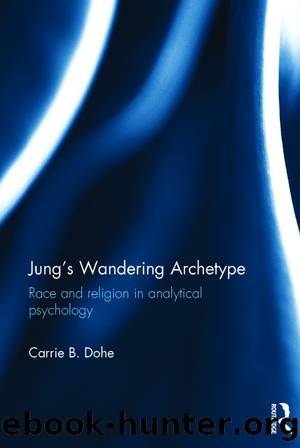Jung's Wandering Archetype: Race and Religion in Analytical Psychology by Carrie B Dohe

Author:Carrie B Dohe [Dohe, Carrie B]
Language: eng
Format: epub
Tags: Psychology, Religion; Politics & State, Religion, Political Ideologies, Mental Health, Political Science, Nationalism & Patriotism, Movements, Jungian
ISBN: 9781317498087
Google: kkmTDAAAQBAJ
Goodreads: 30853033
Publisher: Routledge
Published: 2016-07-01T00:00:00+00:00
Differing primitivities of the âGermanic barbarianâ and âJewish psychologyâ
Jung first discussed the Germanic barbarian in âThe Role of the Unconsciousâ (1918). Although he wished to address the psychological causes of a war in which Switzerland was not an aggressor, he described those responsible in terms that included himself. â[. . .] We Germanic people still have a genuine barbarian in ourselves,â he declared ([. . .] wir Germanen haben noch einen echten Barbaren in uns) (Jung GW 10 (1918):19). In the same line in the English CW, the term âGermanic peopleâ has been deleted, leading an unsuspecting reader to assume Jung was diagnosing a universal psyche. He was not. Nor did he use the term deutsch, a national designation to which he, as a German Swiss, was related but did not belong. Instead, he used a broader linguistic and ethnic term, Germanen, which in Jungâs day invoked a utopian collective image and a presupposition of an unchanging group essence. It was to this unchanging Volk essence that Jung believed he belonged.
Jung described this buried Germanic barbarian as a âblond beast,â an image which he borrowed directly from Nietzscheâs On the Genealogy of Morals, as shown by the marked passage in the copy Jung owned (Bishop 1995, 129). Jung did not share Nietzscheâs unconditional valorization of the blonde Bestie, most probably due to the catastrophe of the world war that separated him from the philosopher. Nor did he correlate the pairs of oppositions that Nietzsche proposed (between noble-common, light-dark, and good-bad) with different races or classes; rather, for Jung, these pairs of oppositions were united in the original wholeness of the primordial unconscious, and were broken apart through the development of individual consciousness. However, Jung did agree with Nietzsche that an outside force acted as the domesticating agent, though Jungâs evaluation of it was more ambivalent than that of Nietzsche. As he would claim years later in conversation with Miguel Serrano (Serrano 1966, 52), Jung wrote that the foreign religion Christianity had split the Germanic barbarian psyche in two, cultivating the lighter (perhaps the spiritual?) portion for civilization while repressing the darker (the chthonic?) side, thereby crippling the instincts of the Germanic man (Jung CW 10 (1918):17, 26). Jung described the undomesticated portion as a lion roaming in its cage, an autonomous psychic power that could seize the civilized portion of the Germanic manâs mind, resulting in either a psychological or social revolution (para. 17). Although Jung described this gripping power as âthe evil essenceâ (Das böse Wesen) (para. 19), his stance towards this unincorporated psychic aspect was by no means purely negative: this repressed content may be dangerous, he wrote, but it also offered the possibility of regeneration, rejuvenation and even rebirth (para. 20).
In line with the model set up by Tacitus and reiterated by the German humanists (see Chapter 2), Jung contrasted the Germanic barbarians with their alleged opposites. In Jungâs day, these were the Jews. âThe Jewâ (in singular) had two cultures, wrote Jung, that of the classical world (die antike Kultur) and the host country (Wirtsvolk) (para.
Download
This site does not store any files on its server. We only index and link to content provided by other sites. Please contact the content providers to delete copyright contents if any and email us, we'll remove relevant links or contents immediately.
Unwinding Anxiety by Judson Brewer(72727)
The Art of Coaching by Elena Aguilar(52899)
The Fast Metabolism Diet Cookbook by Haylie Pomroy(21046)
Rewire Your Anxious Brain by Catherine M. Pittman(18533)
Healthy Aging For Dummies by Brent Agin & Sharon Perkins RN(16987)
Talking to Strangers by Malcolm Gladwell(13197)
The Art of Thinking Clearly by Rolf Dobelli(10184)
Mindhunter: Inside the FBI's Elite Serial Crime Unit by John E. Douglas & Mark Olshaker(9167)
Crazy Rich Asians by Kevin Kwan(9150)
The Compound Effect by Darren Hardy(8790)
Tools of Titans by Timothy Ferriss(8193)
Periodization Training for Sports by Tudor Bompa(8146)
Becoming Supernatural by Dr. Joe Dispenza(8097)
Wonder by R. J. Palacio(7977)
Crystal Healing for Women by Mariah K. Lyons(7844)
Bodyweight Strength Training by Jay Cardiello(7827)
Therapeutic Modalities for Musculoskeletal Injuries, 4E by Craig R. Denegar & Ethan Saliba & Susan Saliba(7676)
Change Your Questions, Change Your Life by Marilee Adams(7614)
Nudge - Improving Decisions about Health, Wealth, and Happiness by Thaler Sunstein(7561)
